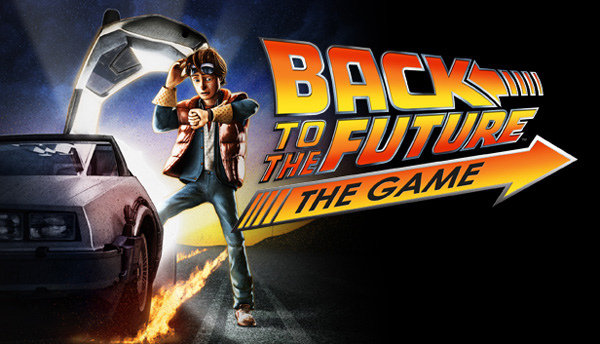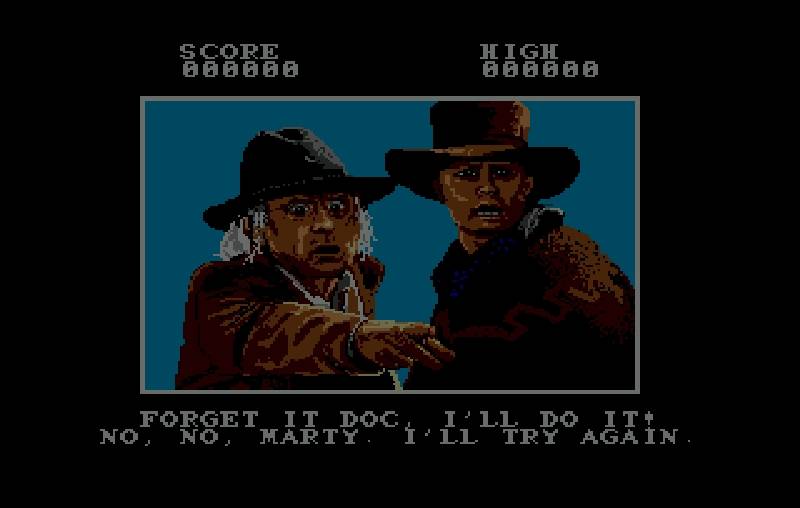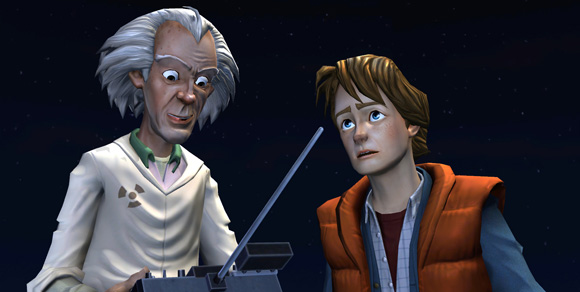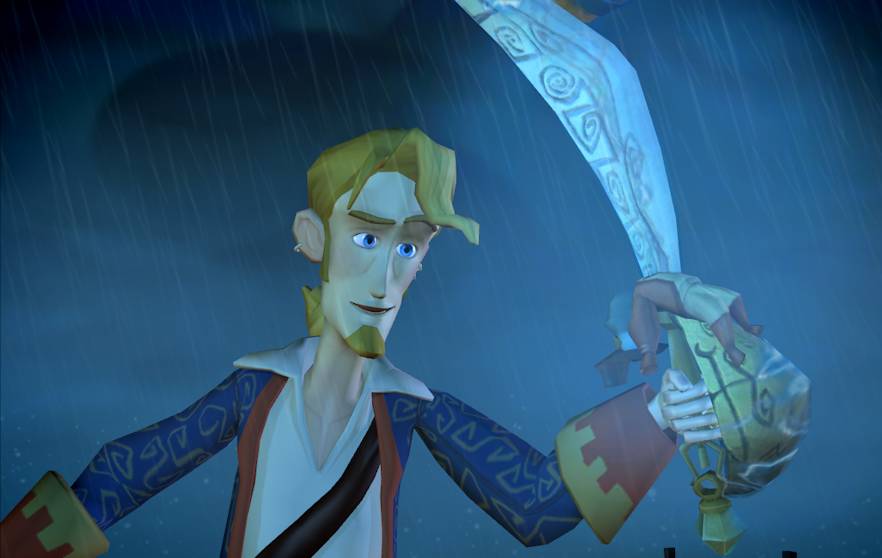
If there are two things from my childhood that I can truly profess my love for, it would be the Back to the Future movies and point-and-click adventure games, such as the Monkey Island series. Maybe my parents. But they never taught me the importance of ensuring the fidelity of the time stream, nor the capacity of root beer to serve has ghost repellent in a pinch, so forget them. In what appears to be Telltale Games latest effort to lure in the coveted “Nikola Suprak demographic,” their latest release somehow combines both. Like a lot of Telltale Game’s games, Back to the Future: The Game is an episodic adventure, the first episode of which was recently released for purchase online. Back to the Future: The Game – Episode 1: It’s About Time (a.k.a. Back to the Future: The Quest For More Punctuation) is surprisingly good, and comes with a full recommendation for anyone who has ever shouted out “1.21 JIGOWATTS” in science class, before being sent to the principal’s office for making out-of-date references.
Although some were ready to roll out the “Game of the Year for 2011” last year before the game was even announced, my anticipation was a bit more tepid. And not just because giving a game about time travel an award preemptively seems so ironic it should find its way into an Alanis Morissette song. See, movie tie-in games in general, and the Back to the Future series specifically, have not always been kind to gamers. There were a series of games released in the late ’80s/early ’90s that carried the Back to the Future name that were a certifiable abomination and crime against humanity, and which multiple studies linked to several forms of cancer including the rare but untreatable cancer of one’s dreams and happiness. The Back to the Future series has the same reputation in video games as Jeffrey Dahmer does in the world of fine cuisine, so I was a bit hesitant to try this latest dish they were serving up when the last one had a couple fingers in it.
 An image from the horrifyingly awful Back to the Future III game for the Sega Genesis, apparently shortly after Indiana Tannen had opened the Ark of the Covenant.
An image from the horrifyingly awful Back to the Future III game for the Sega Genesis, apparently shortly after Indiana Tannen had opened the Ark of the Covenant.
Fortunately, while Game of the Year might be a little much, Telltale Games has actually done a nice job making this game feel like an extension of the movies. Creativity is hard, so too often, games meant to serve as an extension for an already existing piece of fiction take the Ghostbusters: The Video Game route of story telling. Here, the plot serves mostly as a tour guide for past exploits, loudly pointing out “REMEMBER THAT? WASN’T THAT FUNNY?” and referencing the original work so frequently that you can only assume that the writers just wrote down the word “NOSTALGIA” in big capital letters before heading off for lunch. This is why it was so shocking to me when the story and script in Back to the Future: How Many Dashes Can We Fit In One Title? was actually pretty good. It captures the feel of the series without aping it, and manages to build off of previously established characters without losing what made them unique.
The story takes place sixth months after the events of the third movie, and follows the standard Back to the Future plot of saving people in different time periods from whichever Tannen happens to be prowling the area. This time around, Doc Brown has gotten himself into a bit of trouble in the 1930s, and Marty must go to his rescue. He had been investigating what he refers to as a historical mystery, and has gotten himself into a bit of a pinch. While interfering with a mystery from 50 years ago seems like it might have some ramifications throughout history, I’m assuming Doc Brown stopped caring about the time space continuum about the time he impregnated a woman from before the McKinley administration. As Marty McFly, you must save Doc Brown from the trouble he’s gotten himself into, and presumably talk him out from going back in time to bang some cavewoman hookers.
 “And then after I impregnate a few cavewomen, I’ll go back in time and have sex with the first thing that crawls out of the primordial ooze! I tell you Marty, the applications of time travel are limitless!”
“And then after I impregnate a few cavewomen, I’ll go back in time and have sex with the first thing that crawls out of the primordial ooze! I tell you Marty, the applications of time travel are limitless!”
Like most of Telltale Games’ creations, the game is funny, at times laugh-out-loud so. The dialogue is well written and I always went through every conversation option just to see what people would say. More importantly, it feels like a real Back to the Future sequel, and not like Guybrush got stuck into a Back to the Future-themed game. All of the returning characters are handled well and feel true to their roots, while the new characters that are introduced are worked into the story nicely and have a bit more depth than the one-trait stock supporting characters that typically populate this sort of game. It does get off to a bit of a slow start, but things pick up and by the end of the game I was genuinely interested to see what was going to happen next.
At which point, I got a screen telling me I would have to wait for the next episode, and the game might as well have ended with a slap in the face and a “your momma” joke, as it would have had the same result on my temperament. I get the concept behind episodic games, but it has always irked me and the formula itself doesn’t seem like that great of an idea. There will be no point that I was as interested in what would happen next as immediately after the conclusion, and a month or two between games only makes events cloudy in my mind. You don’t read a fifth of a book at a time then take a six week hiatus to twiddle your thumbs, and that is because the plot and characters will begin to fade in the time inbetween.
Additionally, I still don’t fully trust Telltale Games after the Tales of Monkey Island episodes. By the end of the fourth episode in that series, I was hooked and really curious where the game would go next. And apparently, so were the developers, because the last chapter was such a mess it really seemed like they were only planning the story out one chapter at a time. So, while this chapter of the Back to the Future: The Game was funny and well written and all that, there is no guarantee that they won’t decide to resolve the plot with Marty waking up and realizing it was all a dream, or something equally stupid that will end up souring the whole story a bit (say, the female lead telling you that aligning herself with your archenemy was her plan all along to get you to see that OH GOD TALES OF MONKEY ISLAND HATE FLASHBACK).
 “I can’t believe I dreamed the whole thing…AND CONNED YOU SUCKERS OUT OF $25! BWA HA HA HA!”
“I can’t believe I dreamed the whole thing…AND CONNED YOU SUCKERS OUT OF $25! BWA HA HA HA!”
Ahem.
However, a game cannot get by on characters and plot alone, so it is worth noting that the puzzles in the game are enjoyable as well. The game does a nice job breaking up the game into several different segments, each with its own handful of puzzles you need to solve. This actually helps a bit with the pacing, as while one part of the game might have you scouring a larger area to figure out how to get a certain character to help you, another might be limited to one specific room or area, forcing you to figure out the solution with only the tools in your immediate area. While none of the puzzles have that huge “wow” factor that accompany some of the better-made puzzles Telltale Games have done in the past, they are all consistently good and never degrade into the boring collect-and-fetch quest that seems to be a fallback puzzle in this genre. The ending sequence is particularly well done, and without wishing to spoil anything, it is about as climatic as you could expect a point-and-click adventure game to get without going outside the genre.
 Unfortunately, that means the skateboard race against Hitler and the Army of Darkness had to be cut.
Unfortunately, that means the skateboard race against Hitler and the Army of Darkness had to be cut.
There are a couple of issues with the puzzles, however, that keep the game from being perfect. Things have been simplified a bit in comparison to some of Telltale Games’ other releases. This isn’t all bad, and probably sounds great to someone who got stuck for a couple of hours in adventure games in the past because they lacked the brain damage necessary to recognize that a monkey is a perfectly good way to turn a handle, or that combining two sticks, some glue, and the puzzle designer’s special crazy dust was the only way to make the key you needed to proceed. Puzzles certainly are more logical this time around, and there was never a time where, after completing a puzzle, I felt like writing some hate mail to whoever designed it.
Yet, there is a fine line between being simplified and being just plain simple, and the game crosses it at times. While the lack of arbitrary puzzle solutions is nice, it feels like the difficulty was scaled back a bit too much. The combination system from previous games has been removed entirely, and without it the game seems to lack an element of depth. Puzzles as a whole are on the easy side, and there are only a couple that really require you to think. For the most part, the puzzles are solid, but the game does lack the one or two really tricky or clever puzzles that give you a sense of satisfaction for figuring something out on your own without consulting a FAQ. The areas themselves also seem a bit small at times, and while it does break up the gameplay nicely to be forced to work within one small area for a little while, it would have been nice if the big and sprawling portions were a bit bigger and sprawlier, as the game lacks that exploration element that accompanies a really nicely designed adventure game.
From a technical standpoint, the game also gets some kudos. The voice actors for the most part are great, and they even got Christopher Lloyd to reprise his role. There are a couple of minor characters who are voiced by someone that sounds like they just got out of acting school, or possibly just got out of cleaning the cafeteria at the acting school, but for the most part they make the script even better. This game is probably the best-looking game released by Telltale Games, and the game immediately scored some points when I saw that Marty wasn’t given the Guybrush Threepwoord treatment and made to look like he was suffering from the late stages of consumption.
 Seriously, did he run a gypsy woman over with his car, or did the emaciated pedophile look score well with the test groups?
Seriously, did he run a gypsy woman over with his car, or did the emaciated pedophile look score well with the test groups?
There are a couple of other minor annoyances that pop up every once in a while. The game utilizes a click-and-drag interface that controls like a drunk man in a sack race, and moving Marty isn’t as smooth as it could be. Luckily, the game lets you use the arrows in order to get you around, and this works significantly better. Some of my friends complain that the arrow keys are no way to control in a point-and-click adventure game, and back in the good ol’ days you could just click where you needed to go and everything worked better. If you ignore them long enough in their old man rumblings, eventually their arthritis will flare up or the will find a profane-looking cloud to yell at, and you can go on using the arrows because they work perfectly fine.
Additionally, the game has a hint system that is a bit intrusive. I turned the hints off entirely, but for the first couple of areas in the game they kept popping up anyway. I was just walking around, exploring the area, and apparently my laid-back approach set off their moron alarm and the game felt like it needed to grab me by the hand and slap a foam helmet on me in case I hurt myself. They do stop after the first couple of areas, so it really wasn’t a huge problem, but they are bothersome when they last and don’t really serve any point, because if you can’t figure to walk over to the other side of the screen (which is what one of the hints tells you), you most likely aren’t at the level where you can read anything anyway.
I feel a bit weird reviewing the game right now, for the same reason I don’t rush out of a theatre to call my friends about my impressions of a film twenty minutes into it. I mean, I’m anxiously awaiting the next episode and will most likely play it as soon as it comes out, so that is usually a good sign, as I’m not one to wait around the mailbox and wait anxiously for the mail if I know it is only going to contain bills and a notice for jury duty. That not might sound like a ringing endorsement, but Back to the Future: We Get Paid By The Semicolon is about as good as you can expect the first fifth of any adventure game to be. If you like the Back to the Future series or point-and-clink adventure games in general, it is definitely worth checking out. If you like neither, then it might not be your cup of tea, but I’d assume you’d be too busy recalibrating your gears and checking your oil levels to play the game in the first place, because you are clearly a robot that has yet to learn the definition of fun.

Where is my damned PS3 version?! I CAN’T READ NIKOLA’S REVIEW UNTIL I PLAY IT! I DON’T WANT TO BE SPOILED!!
Well done; a nice addition to the GameCola staff, you are.
“You don’t read a fifth of a book at a time then take a six week hiatus to twiddle your thumbs, and that is because the plot and characters will begin to fade in the time inbetween.”
This was EXACTLY my problem with Tales of Monkey Island. The games require you to remember all these little plot details and all these minor characters who have no personalities and you spend three seconds talking to, yet you’re only allowed to play the game for a few hours every six weeks. Telltale’s games are great, but their distrubtion process makes them harder to enjoy for no reason. I feel like it’s almost pointless to buy them as they come out, because you’re limiting your enjoyment of them if you can’t play them all at once.